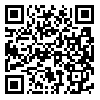Volume 4, Issue 170 (11-2022)
J Except Educ 1401, __(170): 96-96 |
Back to browse issues page
Download citation:
BibTeX | RIS | EndNote | Medlars | ProCite | Reference Manager | RefWorks
Send citation to:



BibTeX | RIS | EndNote | Medlars | ProCite | Reference Manager | RefWorks
Send citation to:
Ashori M. The effect of visual impairment on emotional development and
emotional competence in learners who are visual impairment. J Except Educ 2022; 4 (170) :96-96
URL: http://exceptionaleducation.ir/article-1-2501-en.html
URL: http://exceptionaleducation.ir/article-1-2501-en.html
University of Isfahan , m.ashori@edu.ui.ac.ir
Abstract: (1037 Views)
Abstract
Background and Aim: Emotion is a strong affective perception or feeling that arises from personal
circumstances, one's mood, or communication with others. Emotions are multidimensional and have
holistic structures that consist of different dimensions such as behavioral expression, physiological layers,
phenomenological experience, cognitive processes and social context. The aim of this study was to investigate
the structure of emotion and its components, classification of emotions, the effect of visual impairment on the
development of emotion, identification of emotions in learners with visual impairment, emotional competence
and the application of emotion identification for students with visual impairment. The method of this research
is descriptive and review. Articles and books in reputable scientific databases from 2001 to 2022 were used
to collect information.
Conclusion: The emotional development of children and adolescents with visual impairment develops
differently compared to their normal peers. The ability to accurately identify the emotions of others is
considered central to achieving emotional competence. Understanding the content of other people's
emotional states goes beyond simple understanding of primary emotions such as happiness, anger or
sadness. Although people with visual impairment do not necessarily have a problem in understanding basic
emotions, they are delayed in identifying emotions and especially in identifying higher-order emotions such
as anger, embarrassment, and disappointment. Considering that the social world becomes integrated and
comprehensible for people with visual impairment through the understanding of these emotions. Therefore,
it is possible to improve the development of their emotional competence by teaching higher-order emotions.
Background and Aim: Emotion is a strong affective perception or feeling that arises from personal
circumstances, one's mood, or communication with others. Emotions are multidimensional and have
holistic structures that consist of different dimensions such as behavioral expression, physiological layers,
phenomenological experience, cognitive processes and social context. The aim of this study was to investigate
the structure of emotion and its components, classification of emotions, the effect of visual impairment on the
development of emotion, identification of emotions in learners with visual impairment, emotional competence
and the application of emotion identification for students with visual impairment. The method of this research
is descriptive and review. Articles and books in reputable scientific databases from 2001 to 2022 were used
to collect information.
Conclusion: The emotional development of children and adolescents with visual impairment develops
differently compared to their normal peers. The ability to accurately identify the emotions of others is
considered central to achieving emotional competence. Understanding the content of other people's
emotional states goes beyond simple understanding of primary emotions such as happiness, anger or
sadness. Although people with visual impairment do not necessarily have a problem in understanding basic
emotions, they are delayed in identifying emotions and especially in identifying higher-order emotions such
as anger, embarrassment, and disappointment. Considering that the social world becomes integrated and
comprehensible for people with visual impairment through the understanding of these emotions. Therefore,
it is possible to improve the development of their emotional competence by teaching higher-order emotions.
Type of Study: Review Article |
Subject:
Visual Impaired
Received: 2022/Jul/Tue | Revised: 2023/Jan/Tue | Accepted: 2022/Oct/Sat | Published: 2023/Jan/Tue | ePublished: 2023/Jan/Tue
Received: 2022/Jul/Tue | Revised: 2023/Jan/Tue | Accepted: 2022/Oct/Sat | Published: 2023/Jan/Tue | ePublished: 2023/Jan/Tue
Send email to the article author
| Rights and permissions | |
 |
This work is licensed under a Creative Commons Attribution-NonCommercial 4.0 International License. |





